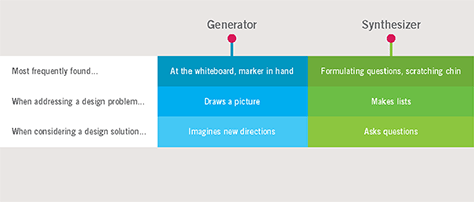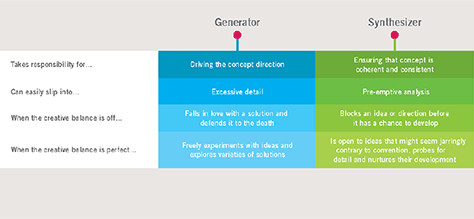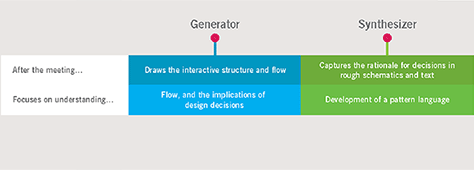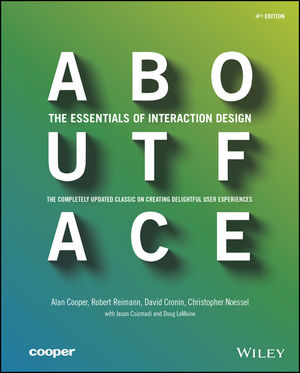Getting Started with Thought Partnership
If you want to establish thought partnership in your practice, you could begin by creating Generator or Synthesizer roles and then finding people to fill them. You could also start leaner, finding small ways to apply elements of the practice that are appropriate to your work. It can take a while to determine what kind of partnership you need, but you can start with simple steps.
Finding a Partner Who Generates
- Before you begin, clarify the problem you want to solve.
- Appeal to the generative capabilities of a colleague or friend: “I need someone to help kick-start some ideas.”
- If things don’t work at first in the meeting, walk up to the board and draw a bad idea. If your partner is a good Generator, he or she will leap up and begin building on the bad idea or offer a counterproposal.
Finding a Partner Who Synthesizes
- Before you begin, make sure you’re designing for a higher-level “story” or scenario. This will help give your partner a rubric from which to work during the meeting.
- Appeal to your partner’s evaluative capabilities: “Can you help me figure out whether this idea is any good?”
- If things don’t immediately go well in the meeting, work on the story. Make sure you’re both clear on what the user is doing and why.
Switching Roles on the Fly
Establish ground rules at the beginning of your partnership. Synthesizers should probe and guide; Generators should explore and ideate. You can swap roles within a meeting, but it’s a good idea to make this switch explicit. When a Synthesizer comes up with a great idea, he must resist the urge to wrest the marker away from the Generator. Instead, he can simply offer to switch roles: “Mind if I generate for a bit?”
Getting Unstuck (The 15-Minute Rule)
Small groups of creative people sometimes hit a wall. Ideas won’t flow; conversations swirl or get mired in detail. In our practice, we encourage teams to bring in another designer if the discussion doesn’t advance for 15 minutes. The core team should brief this outsider on simple contextual details: the user, the scenario, and the ideas under consideration. The outsider should, in turn, probe the designers for rationale: Why is this good? How does this help? Almost invariably, this simple conversation helps lift the designers out of the details and move beyond the impasse in a matter of minutes.
Rightsizing Core Teams
If two are good, three must be better, four would be amazing, and ten could bend space and time. Right? Organizations large and small fall victim to an additive urge when building teams. In our experience, teams are most effective when the members have clear roles and when the teams are small and nimble. This is why we have applied the moniker “core team” to the unit responsible for getting work done.
In Scaling Up Excellence, Stanford business professors Robert Sutton and Huggy Rao cite numerous examples in which bigger teams actually produce worse outcomes; they call this phenomenon “The Problem of More”:
“Employees in bigger teams gave others less support and help because it was harder to maintain so many social relationships and to coordinate with more people … The key challenges are how to add rules, tools and people without creating [bloat].” [2]
In our practice at Cooper, we steer clear of bloat by insisting on four things: small teams, clear roles, tight decision-making loops, and minimal “work about work.” That last phrase describes any activities that are not directly tied to making progress on the core objectives of product development: coming up with great ideas and shipping great products. Status e-mails and quick, noncritical check-ins are examples of “small” tasks that can accumulate and end up requiring significant effort and coordination. If you’re reading this book while you’re in a nonessential meeting, you’re sinking in the quicksand of “work about work.”
By localizing decision-making and being proactive about planning milestones and check-ins, we carve out space for a small set of creative teammates to flourish. In specific numeric terms, our rule of thumb for the rightsized core team to focus on an individual problem is no more than four, and no fewer than two. A minimum of two enables rapid evaluation and iteration. Teams with more than four members have too much overhead, too many people to please, and too much opportunity to lose momentum.
Finally, remember that a small team can be nimble only when roles are clear, responsibility for success is shared, and abilities are complementary. The following sections discuss the various participants in teams large and small and provide some tips for getting the most out of them.
Working Across Design Disciplines
The Synthesis-Generation model can be applied to any professionals engaged in creative discussion. In our practice, it provides structure when any two individual designers are collaborating—visual designer and interaction designer, two interaction designers, designer and developer, interaction designer and creative lead. While the practice of user experience design has become more established, practitioners often find themselves in new collaborative situations with creative professionals from many backgrounds. This model can be usefully applied in many core team situations, with participants from various disciplines.
Over a product’s lifetime, designers across disciplines must do more than merely communicate. Interaction designers must coordinate and cooperate with visual and industrial designers, staging decision-making so that each discipline is equipped with the material it needs to work most effectively. The following sections offer a framework for understanding the distinct responsibilities of each discipline, along with a summary of how the disciplines can work together effectively.
Interaction Design
Interaction designers are responsible for understanding and specifying how the product should behave. This work overlaps with the work of both visual and industrial designers in a couple of important ways. When designing physical products, interaction designers must work with industrial designers early on to specify the requirements for physical inputs and to understand the behavioral impacts of the mechanisms behind them. Interaction designers cross paths with visual designers throughout the project. In our practice, their collaboration begins early, as visual designers guide discussions of the brand and emotive aspects of the experience in discussions with users and the extended team.
Visual Interface Design
In our practice, we’ve come to recognize that visual interface design is a critical and distinct discipline that must be conducted in concert with interaction design and—when appropriate—industrial design. It has great power to influence a product’s effectiveness and appeal. But for this potential to be fully realized, visual design must not be an afterthought—it isn’t a “coat of paint.” It should be regarded as one of the essential tools for satisfying user and business needs.
Visual interface designers’ work emphasizes the organizational aspects of the design and how visual cues and affordances communicate behavior to users. These designers must work closely with interaction designers to understand the priority of information, flow, and functionality in the interface and to identify and strike the right emotive tones.
Visual interface designers focus on how to match the interface’s visual structure to the logical structure of both the users’ mental models and the application’s behaviors. They are also concerned with communicating application states to users (such as read-only versus editable) and with cognitive issues surrounding user perception of functions (layout, visual hierarchy, figure-ground issues, and so on).
Visual interface designers must have command of basic visual properties—color, typography, form, and composition—and must know how these can be used to effectively convey affordances, information hierarchy, and mood. Visual interface designers should be aware of brand psychology, know the history of graphic design, and be familiar with current trends. They must know accessibility principles and the science of human perception. Visual interface designers also need a fundamental understanding of interface conventions, standards, and common idioms. (Read more about Goal-Directed visual interface design in Chapter 17.)
Graphic Design
Until the last 20 years or so, the discipline of graphic design was dominated by the medium of printed ink, as applied to packaging, advertising, environmental graphics, and document design. These traditional practices were not developed to address the demands of pixel-based output. However, the discipline has evolved considerably in the last two decades, and graphic design has become rigorous and eloquent in its approach to digital, screen-based media.
Talented, digitally fluent graphic designers excel at providing rich, aesthetically pleasing, exciting interfaces. They can create beautiful and appropriate surfaces for the interface that establish a mood or connection to a corporate brand. For them, design is often first about the tone, style, and framework that communicate a brand experience, secondarily about legibility and readability of information, and finally about communicating behavior through affordances (see Chapter 13).
Visual Information Design
Visual information design is concerned with the visualization of data, content, and navigation, rather than interactive functions. It is distinguished from information design in that it is less concerned with the content’s editorial and information architecture issues, focusing instead on the graphical presentation. This skill set is particularly important in designing data-intensive applications, where users spend much of their time with complex content.
The primary goal of visual information design is to present data in a way that promotes understanding. This is accomplished by controlling the information hierarchy through the use of visual properties such as typography, color, shape, position, and scale, as well as how these attributes change over time. It can also include microinteractions with information displays that expose details or connections to additional information. Common applications of visual information design include charts, graphs, sparklines, and other means of displaying quantitative information. Edward Tufte has written several seminal books that cover this topic in detail, including The Visual Display of Quantitative Information (Graphic Press, 1993).
Industrial Design
When designing a convergent product, industrial designers must define the form of the physical product, embodying the brand with shape and material. For the purposes of interaction design, they specify physical input mechanisms. Interaction designers can perform research into the users’ overall needs and the device’s goals as a whole. Industrial designers lay the groundwork for their concepts with competitive analysis and materials research. The input mechanisms should not be specified before the desired interaction paradigms are known. Interaction iterations of the software’s primary elements should be conducted in parallel with industrial design concepts so that the outcomes of each can inform subsequent phases. Throughout, interaction designers benefit from the materials expertise and ergonomic acumen of industrial designers, and the industrial designers benefit from the holistic experience vision created by the interaction designers.
Much like the difference in skills between graphic designers and visual interface and information designers, a similar split occurs among the ranks of industrial designers. Some are more adept at creating arresting and appropriate forms for objects, and others emphasize logical and ergonomic mapping of physical controls in a manner that matches user goals and communicates device behaviors. The increase in software-enabled devices that use rich visual displays demands a concerted effort on the part of interaction designers, visual interface designers, and industrial designers to produce complete and effective solutions.
The interplay of these roles involves much more subtlety, and many great resources explore this topic in detail. Kim Goodwin’s book, Designing for the Digital Age (Wiley, 2011), offers practical techniques and tips for defining roles and establishing thought partnership in the context of a design project.
The Extended Team
The preceding discussion covered practices that allow great design to happen among a small core team. But for design to transform into a shipping product, the design must enter the minds and hearts of many more people. Will the rest of the extended team understand its value? Will they indulge it long enough to give it the kind of critique that makes it better? Even if it survives early whiteboard sessions, will it survive a presentation to the product owner? If the product owner gets behind it, will it be understood, implemented, and extended effectively by the production engineers?
The following discussion is intended to outline a few simple strategies for integrating design in large-scale product-focused teams. It’s not intended to be a comprehensive accounting of the best practices in product or service design and development. Very few ideas are truly great. This is why you need timely, candid feedback from capable collaborators, both among your core team and across the extended product team. This section discusses the frequent major participants within product teams. Emphasis is placed on how and when to collaborate with them so that your ideas get the kinds of critiques they need, at the appropriate time.
Areas of Responsibility and Authority
Designers are never the sole participants in creating a great interactive experience. Within digital product organizations, the expertise of engineers, marketers, and business stakeholders must be interwoven with the work of design in a product’s creation and evolution. The following list describes a division of responsibilities, balanced by an equal division of authority among those different disciplines:
- Design is responsible for users’ goals for the product. Many organizations currently do not hold any specific person, or team, responsible for goals. To carry out this responsibility, designers must have the authority to decide how the product will look, feel, and behave. They also need access to information. They must observe and speak to potential users about their needs, to engineers about technological opportunities and constraints, to marketing about opportunities and requirements, and to management about the kind of product to which the organization will commit and the results they expect.
- Usability is responsible for validating that users respond to the design as intended and that the overall experience and detailed interactions have the desired effect— being useful, usable, and desirable. To be effective, usability should be independent from but collaborative with the design group, and both usability and design should report to a decision-maker who can weigh the results from an informed and objective standpoint, and has the authority to have any necessary corrections to the design or implementation enforced. Usability’s strength is in identifying problems, while design’s strength is in identifying solutions. Collaboration works best when this division of labor is maintained.
- Engineering is responsible for construction. This means that they must have authority over the raw materials and construction processes—development platforms and libraries, for example—along with the relative difficulty ratings and cost of the items in their backlog. The engineering and design teams must stay in touch when those items are being prioritized. Designers must review and react to the implementation of form and behaviors, and both teams must evaluate the success or failure of the overall experience as it is developed and tested. Designers should rely on engineers to provide guidance on technical constraints and opportunities, as well as the feasibility of proposed design solutions.
- Marketing is responsible for defining the market opportunity as a set of customer needs, preferences, and motivations. This team also eventually must convince customers to purchase the product. To do this, the marketing team must have the authority to advocate for the most lucrative, or beneficial, customer segments. Its members must provide guidance in targeting design research with the appropriate users, and the team must have access to the outcomes of that design research. (It’s worth noting that, as we discuss in Chapter 3, customers and users are often different people with different needs.)
- Business leads are responsible for defining the business opportunity, because they’re also accountable for the product’s profitability. This group must drive decision-making around where opportunities for differentiation exist, and what features and functions must be prioritized across the extended team. To make those decisions, business leads need to receive clear information from the other groups: design’s research and product definition, marketing’s research and sales projections, and engineering’s estimations of the time and cost to create the product.
Collaboration among these teams best happens in two venues: at frequent, informal working meetings where new ideas are explored, evaluated, and elaborated on; and at checkpoints that correspond to the end of each phase in established processes. Working meetings are particularly important for engineers once the design has begun to gel, and they are critical for marketing in the project’s early and late stages.
As the product vision evolves, each team must continually seek to address its core concern:
- Designers—What are the simplest, most coherent, most delight-inspiring mechanisms for crafting the experience?
- Usability professionals—Does the design deliver on its promise of usefulness, usability, and desirability? Do users really use the product as assumed in the design?
- Engineers—How do we deliver the experience in a way that is fast, robust, scalable, and extendable?
- Marketers—How can we inspire adoption?
- Business leaders—Where is the most evident overlap of product function and market need?
When team members focus on those questions and ensure that they’re prioritized appropriately, extended team interactions are clear and direct.
Collaborating with Agile Developers
Designers imagine and specify the right experience: a form that delights users, an experience that feels right, behaviors that fit use. Developers offer a corollary: The right experience should be built in the right way. We once believed that all design work should be completed before coding begins, but we’ve come to learn that this is neither desirable nor practical. Clear benefits arise from methodically testing and proving the feasibility of design hypotheses along the way.
Agile development methods arose as a response to the very real drawbacks of “waterfall” methods, which are characterized by years-long development timelines, hundred-page requirements documents, processes with various “gates” to ensure “quality,” and dozens of participants. Agile methods seek to optimize time and energy, reduce waste, and ensure that concepts actually deliver value to users. They encourage many of the same principles discussed early in this chapter—small teams, focused work, and frequent discussion. Yet although they have evolved the practice of software development, agile methods also complicate—and, in some cases, short-circuit—design work.
This section discusses ways to ensure that the work of designers informs and shapes the development of products developed with agile methods. Let’s first understand a couple of fundamental perspectives on agile methods:
- Business stakeholders tend to love the idea of agile development because it sounds economical and efficient. Yet business stakeholders often don’t realize until much later that building fast means thinking fast, and fast thinking requires a solid foundation of assumptions and expected outcomes. If no underlying foundation or shared vision exists for what should be built and tested, agile work is aimless and, contrary to promises, wastes time.
- Developers tend to love agile methods because such methods support more of what they love (coding) and less of what they don’t (sitting in meetings, interpreting requirements documents). When misapplied, however, this way of working can result in heads-down sprinting toward hazily specified destinations, resulting in just as many frustrating dead ends as classic waterfall methods.
In our experience, agile development is highly successful when core product elements are clearly rendered, widely understood, and implemented so that they can be tested well. Thus, we have found that the primary elements of an experience should be planned, visualized, and discussed before they are built. Even in a highly iterative process, informed planning should precede construction. You must think before you do. This is a much messier reality than the neat sequential compartmentalization of design and construction, but it can initiate a productive dialog between designers, developers, and business decision-makers.
The remainder of this section covers a couple of simple questions at a high level:
- What does design mean in an agile context?
- How should designers adapt their practice in fast-paced, agile ways?
The Work of Designers on an Agile Team
Interaction designers seek simplicity and cohesion, knowing that cohesive solutions won’t appear fully formed on day one. They emerge over time, hewing to the spirit of Antoine de Saint-Exupé´ry’s oft-cited design aphorism: “Perfection is attained not when there is no longer anything to add, but when there is no longer anything to take away.” [5] Waterfall methods are friendlier to this way of working, because they provide time for ideas to develop and for their flaws to be revealed and removed. Agile methods value speed and focus on small iterations, but they reward designers with a chance to understand how users interpret design in progress.
In agile contexts, designers must prioritize and visualize; they can bring clarity and concreteness to desired outcomes and facilitate conversations around what elements must be developed to achieve them. This sounds similar to the work of design in many other contexts, but there are two important differences:
- There can be tension, or outright disagreement, in how the experience is defined when people work in agile teams. Designers must be able to define the critical elements of the user experience while working in concert with developers who may reveal constraints on or obstacles to that definition.
- Designers must think differently about the inputs to, and outcomes of, their practice. Agile development allows for feedback from users early on and often. This is an opportunity, and designers should appreciate it as such.
Designers rarely get a chance to fully visualize and perfect a user experience vision in an agile environment. But they must advocate for goal-directedness in the definition of the product and in the prioritizing of items in development.
Defining the User Experience on Agile Teams
At the beginning of a collaborative effort with agile developers, designers will want to quickly assess how much of the experience has already been defined, specified, or implied.
This definition could be explicit—in the form of a wireframe created by a lead architect or business stakeholder—or implicit, in the form of shared assumptions about how it will work, the implementation technologies used, and so on. Designers should expect to shape the primary elements of the user experience—layout and navigational metaphors, the information architecture, transitions and animations that establish a sense of polish. Therefore, it’s important to reckon with predetermined implications and constraints.
On the best agile teams, the designers specify the foundation of the experience while the developers lay the non-user-facing technical foundation. In less-optimal cases, designers need to move quickly to confront assumed specifications, especially those that prematurely determine an important aspect of the experience. These conversations can be difficult, but the whole point of user experience design is to express the product hypothesis through the user interface.
In our practice, agile developers can be capable thought partners at this stage. Talented developers think deeply about the infrastructure and connective tissue of interactive products, and they bring a healthy perspective on where the true engineering complications lie. In the best cases, they provide useful direction toward the right level to apply design and ensure that the work of design is useful and readily implemented. In the worst cases, neither developers nor designers understand the value of the others’ expertise.
Doing valuable work on an agile team is much like doing it in other contexts. It always comes down to articulating users’ goals, context, and flows; visualizing and iterating the desired experience; and prompting, gathering, and interpreting frequent user feedback. On agile teams, designers must be able to quickly determine where the biggest user experience challenges lie and to ensure that related elements flows are defined before development begins.
For case studies in the collaboration of user experience designers and agile developers, read the Smashing Magazine article “Lean UX: Getting Out of the Deliverables Business,” by Jeff Gothelf and Josh Seiden. [3] It’s a fine primer on the ways in which user experience design can be applied in specific agile development contexts.
Incorporating User Feedback
For designers, the most valuable by-product of agile processes is feedback on the user experience—and lots of it. This feedback can be highly useful, as long as it is prompted, gathered, and interpreted appropriately. When you’re a designer, it’s critical to determine what you want to learn about the user experience during each release of new features or functions.
Feedback in an agile context is fast-paced but familiar. Early on, the prompts should be directed toward understanding whether the fundamental user hypothesis is correct. Do the expected users derive the expected value? How well do the primary elements serve them? It’s also important to look for what is working, independent of what you hoped would work. What are people using? Why?
As development continues, feedback can be more focused: Do the primary elements flow well? How are they accessed? What isn’t used? Where do users stumble? What surprises users?
Establishing a Creative Culture
Establishing teams is essential, but a team full of capable people doesn’t guarantee good output. Great teams emerge and develop because they’re placed in environments physical and virtual—that nourish them. In our experience, the team’s cultural and social dynamics are as important as clarity around roles. Does the team enjoy working together? Do they have fun together? Do they have compatible schedules? Interests? Ways of working? Senses of humor?
Renowned record producer Steve Albini once laid out his expectations in a letter to a band before they entered the recording studio:
“I have worked on hundreds of records, and I have seen a direct correlation between the quality of the end result and the mood of the band throughout the process. If the record takes a long time, and everyone gets bummed and scrutinizes every step … the end result is seldom flattering.” [4]
A famous recording studio doesn’t guarantee a good record, nor does a great producer. These ingredients are important, but those investments are wasted if the session is unproductive. Process can provide structure, but the ideas themselves need light and life to emerge and develop. Creating a positive, productive organizational culture is a topic that is too big to fully explore in this space, but it’s too important to omit. Here is some of the raw material of an organizational culture; consider how you can use these elements to promote the cultural oxygen required to fuel the spark of creativity:
- Environmental serendipity—Creative organizations can go overboard with environmental design, but there’s a method in what may seem like madness: Casual interactions with people, artifacts, or architectural moments set the tone for creativity. Small environmental surprises—a bold color, a new texture, an interesting surface— offer external encouragement for sparky ideation.
- Small workspaces—An ideal workroom announces itself as a place that is friendly to creativity, providing surfaces and tools for sketching, along with room to move around. Nothing kills momentum more often than distraction, so a workroom should block out as much of the outside world as possible. A door is the typical architectural method of achieving this goal, but doors can be rare in open floor plan workplaces. Find a corner, erect barriers, and keep out the rest of the world as you dive deep into a problem.
- A collaborative code of conduct—The team should agree on how they’ll work together. Clarity and trust in one another’s roles, responsibilities, and work habits are essential. Small rituals are the foundation of good teamwork. Meeting start times, durations, breaks, and agendas can seem inconsequential, but small problems can accumulate. Focus must be established together, so turn off your phone and close your laptop. Like a growing pile of dirty dishes in the kitchen sink, minor inattentions can easily overwhelm good intentions. Do your dishes, hold your teammates accountable, and get to work.
- Space for positive digression—Digressions can seem egregious until they deliver you to unexpected insight. When a team is pressed for time, a digression can feel wasteful and sap energy. Teams who are open to digression tend to have more wide-ranging discussions and arrive at more interesting and more carefully considered solutions. The moral: Leave some time to stray.
Paying attention to the social dynamic is critical throughout the lifetime of the partnership. When there’s conflict within the team, progress slows, quality decreases, and the end result flatters no one. For a design team, a solution of poor quality should be the ultimate bummer.
Identifying Skill Levels in Designers
Designers’ skills must meet the scale or depth of a design problem. Craftspeople get bored with simple problems; apprentices may end up with subtle, sophisticated problems that their skills can’t match. In both cases, the product suffers, and the reputation of the design organization can take a hit. Design leaders must ensure that problems are rightsized to the abilities of the designers in their practices. This requires a keen sense of a problem’s location, size, and impact before the design work even begins.
Here’s a quick guide to how we think about the levels of experience and the skills required at each level:
- Apprentices are early career designers who must be matched with mentors to guide their skill development. It can take considerable time and effort to develop the design judgment that allows apprentices to reliably provide solid, sound ideas that truly fit the task of the design problem. In the process of developing these skills, apprentices must be allowed to stretch to solve problems beyond their skill levels, but they need strong support and guidance from senior teammates while doing so.
- Craftsmen—With time, designers achieve more and more independence as they master their craft. This allows them to take a leadership role within a core team and drive a creative vision every day. Many designers spend their entire career at this level, especially if they’re less inclined to take on the responsibilities of organizational leadership.
- Leaders possess high levels of design craft, along with the willingness and aptitude to provide organizational leadership. In large-scale product companies, a design leader is essential in providing guidance and structure for the design team, advocating for budget and authority, scoping and prioritizing projects, promoting the cause of design, and hiring designers.
Progressing up the ladder of design skill comes down to developing design judgment. How quickly can a designer recognize the fitness of a solution to its task? And how reliably can she guide a team toward a better solution or a deeper understanding of the problem? Leaders must supplement hard skills in design judgment with mentorship skills and organizational savvy. Not every designer aspires to develop these capabilities, and “leadership” is by no means the only, or most optimal, endpoint for highly talented craftsmen.
Collaboration Is the Key
There is no recipe for creative vision or good design judgment. Even when you believe you have the right concept, it takes considerable hard work, diligence, and skill to execute it well. One of the most challenging and chaotic but ultimately rewarding aspects of this hard work is collaborating with the rest of the product and business team. The vertigo caused by these struggles and challenges has motivated us to take a methodical approach.
We have found that designers should be able to collaborate with all the other people on the project team whose work impacts the overall user experience. Depending on the project, this may include design strategists, user and market researchers, user documentation writers, packaging designers, and possibly even store and point-of-sale designers. The point of this collaboration is to ensure that all aspects of the user experience are in harmony. They shouldn’t work at cross purposes or use different design languages that could ultimately confuse the user or muddy the product’s message.
Ultimately, the successful delivery of a product that meets people’s needs requires the careful coordination of the efforts of a large number of people. We’ve found that to be effective, designers must ultimately assume considerable responsibility for orchestrating a fine balance between the numerous forces pushing and pulling on a product. We hope that the tools described in this chapter will help you create great digital products that truly satisfy your users and customers. 
Discount for UXmatters Readers—To claim your 30% discount, order About Face: The Essentials of Interaction Design, 4th Edition, from Wiley.com and enter the promo code UXMAT when checking out. This offer is valid until April 30, 2015.
This chapter is excerpted with permission from the publisher, Wiley, from About Face: The Essentials of Interaction Design, 4th Edition, by Alan Cooper, Robert Reimann, David Cronin, and Christopher Noessel. Copyright © 2014.
Notes
1. Kahneman, 2011, Page 5.
2. Sutton and Rao, 2014.
3. Gothelf, Jeff. “Lean UX: Getting Out of the Deliverables Business.” Smashing Magazine, March 7, 2011. Retrieved November 17, 2014.
4. Hulme, Meadows. “Steve Albini’s Letter to Nirvana Before He Produced in Utero.” Don’t Panic, November 27, 2013. Retrieved November 17, 2014.
5. Saint-Exupéry, 2002.





 In the Introduction to this book, we described the Goal-Directed method as consisting of three p’s: principles, patterns, and processes. However, there’s a fourth p worth mentioning—practices. This book mostly concerns itself with the first three, but in this chapter we’d like to share a few thoughts about the practice of Goal-Directed design and how design teams integrate into the larger product team.
In the Introduction to this book, we described the Goal-Directed method as consisting of three p’s: principles, patterns, and processes. However, there’s a fourth p worth mentioning—practices. This book mostly concerns itself with the first three, but in this chapter we’d like to share a few thoughts about the practice of Goal-Directed design and how design teams integrate into the larger product team. 


